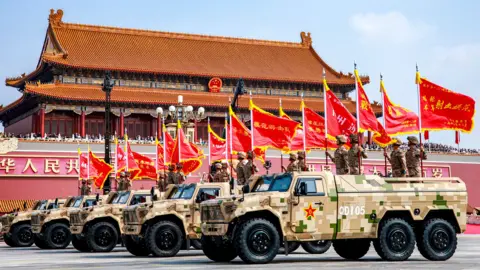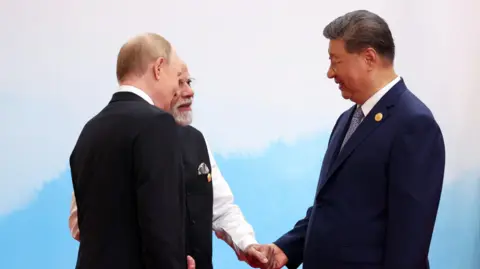China’s Victory Day Parade Highlights Risks for Trump’s High‑Risk Trade Strategy
Beijing’s show of military strength and pageantry prompted terse remarks from President Trump and renewed questions about the global effects of his trade policies
China staged a massive military parade in Beijing on Wednesday to mark the 80th anniversary of the end of World War Two, a display that commentators say underscores the potential dangers of a high‑risk U.S. trade strategy advocated by President Donald Trump.
Thousands of troops, military vehicles and aircraft took part in the event on Tiananmen Square, a spectacle the Chinese government framed as both a commemoration and a demonstration of national power. The parade coincided with Trump’s Oval Office meeting with Polish President Karol Nawrocki, where the U.S. president said he had watched the proceedings and described them as "very, very impressive," adding: "They were hoping I was watching, and I was watching."

Analysts say the parade was intended to send a clear message to foreign audiences: that China is consolidating its military capabilities and presenting itself as an alternative centre of influence to the U.S.‑led international order. The timing and scale of the event, coupled with tightly choreographed imagery, heightened attention in Washington over how American economic and strategic choices might shape future balance of power.
Critics of Mr. Trump’s trade approach have long warned that aggressive tariffs, trade restrictions and economic confrontation with Beijing could accelerate Beijing’s push for self‑reliance, greater investment in domestic industry and expanded defence capabilities. The parade supplied a visible illustration of the stakes: a country emphasising its military modernisation at a moment of intensified economic rivalry with the United States.
Trump’s public comments were limited and non‑committal. Speaking to reporters in the Oval Office, he offered admiration for the spectacle but did not elaborate on policy implications or whether the display had altered his calculus. His remarks were described by aides as a mix of ambivalence, grievance and concern, reflecting the broader tension in Washington between confronting China economically and managing the strategic risks of a deeper split.
The parade also reinforced narratives inside China about national resurgence and sovereignty that Beijing’s leadership has promoted in recent years. Officials in Beijing have framed military modernisation as necessary to safeguard national interests and to project influence across Asia and beyond. Observers say such messaging can bolster domestic legitimacy while signalling to foreign governments that China intends to defend its expanding global interests.
Observers in Washington and allied capitals are weighing how trade policy decisions affect broader strategic competition. Some foreign‑policy analysts argue that sustained economic pressure can be an effective lever for change; others caution that harsh economic measures without parallel diplomatic engagement risk pushing Beijing toward greater economic and technological independence and a more assertive military posture.
The parade and the immediate U.S. reaction come amid an evolving debate over how best to balance economic competition with China and efforts to preserve international institutions and alliances. Policymakers face competing priorities: protecting domestic industries and jobs, maintaining economic ties that underpin global supply chains, and deterring or responding to geopolitical moves by a rising power.
As leaders digest the imagery from Beijing and assess the trajectory of U.S.‑China relations, the episode underscores how symbolic displays of power can influence policy discussions. The Trump administration has not announced a change in trade strategy following the parade, and White House officials gave no detailed comment on whether the display would prompt adjustments to tariffs or broader economic measures.

Longer term, experts say the interaction between economic policy and geopolitical competition will remain central to U.S. planning. The parade provided a high‑visibility reminder that military, economic and political instruments are interconnected in shaping global order — and that decisions made in Washington on trade and investment reverberate far beyond economic tables.
Officials on both sides have emphasized the need to manage confrontation carefully. For now, the Beijing spectacle has intensified debate in Washington over whether current U.S. tactics are likely to produce the desired strategic outcomes or to produce unintended consequences that bolster the position of a resurgent China.